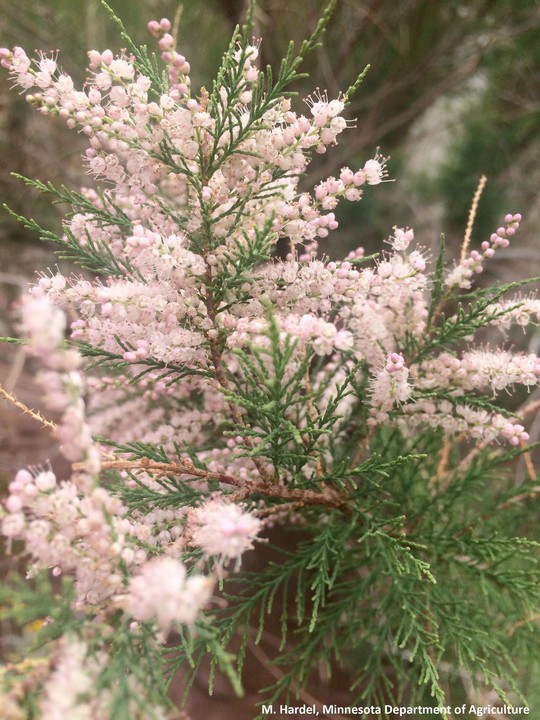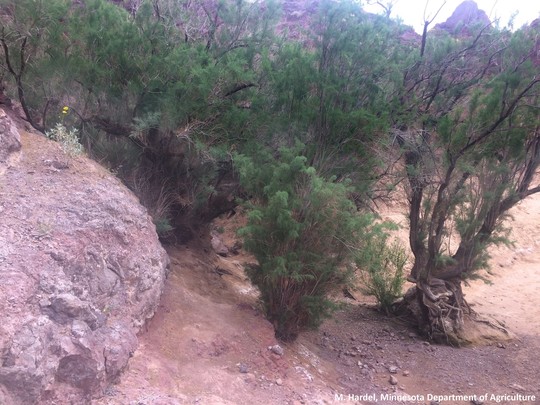|
December 4, 2019
December Weed of the Month: Saltcedar
Christina Basch, Minnesota Department of Agriculture
Saltcedar (Tamarix ssp.) or tamarisk were introduced to the United States in 1823 on the East Coast. They were originally planted as ornamentals, to create wind breaks and to provide shade and stabilize streambanks, but their negative impacts have surfaced within the last few decades.
Saltcedar were first reported escaping cultivation in the 1870s. In the southwestern United States, they quickly outcompeted native willows and other riparian shrubs and reduce water levels. Although arid regions of the Southwest have been hardest hit by tamarisk species, there are increasing reports of saltcedar invading grasslands in the Dakotas and western Minnesota. To better understand the threat that saltcedar poses to Minnesota, it was selected for evaluation by Minnesota Department of Agriculture’s Noxious Weed Advisory Committee.
Tamarisk is a group of species of old-world shrubs originating from southern Europe, northern Africa and western Asia. They develop scale-like leaves that produce clusters of pink or white flowers along terminal ends.
 A close-up of saltcedar leaves and flowers.
They are called saltcedar because of their cedar-like leaves and their ability to increase soil salinity surrounding infestations. Tamarisk are prolific seed producers and can continually produce seeds throughout the entire growing season in lower-elevation areas.
In the Southwest, tamarisk establishes quickly in areas where water pools (river banks, low elevation drainage basins), and have been reported overtaking 90% of native vegetation along corridors of the Colorado River system.
Tamarisk develops an extensive taproot that reduces the water table height - reducing available water for the surrounding native species. Their deep taproots take up saline water, then excess salts are expelled from the leaves. This increases the soil salinity which inhibits the growth of other plants.
 A saltcedar infestation.
Tamarisk are difficult to control. They respond well to a combination of cutting and herbicide applications when timed correctly, and a tamarisk biocontrol beetle is used readily in the southwestern United States. Herbicides have not been effective unless they are applied during a short window before the leaves drop. Naturalizing tamarisk populations have not been reported in Minnesota. If you suspect that you have found a tamarisk species that has escaped cultivation, please do the following:
- Note the exact location with address or GPS coordinates.
- If it is possible, take digital photos of the whole plant, rosettes, flowers, and seed stalks that can be emailed for identification.
- Infestations can be reported to one of two places:
- Contact the MDA by email at arrest.the.pest@state.mn.us, or voice mail 1-888-545-6684.
- Report directly to EDDMapS through the Great Lakes Early Detection Network app on a smartphone or tablet.
PHOTOS
Caption: A close-up of saltcedar leaves and flowers. (Click here to download)
Caption: A saltcedar infestation. (Click here to download)
MEDIA: For more information on Weed of the Month, contact Allen Sommerfeld, MDA Communications, at allen.sommerfeld@state.mn.us or 651-201-6185
Having trouble viewing this email? View it as a Web page.
|